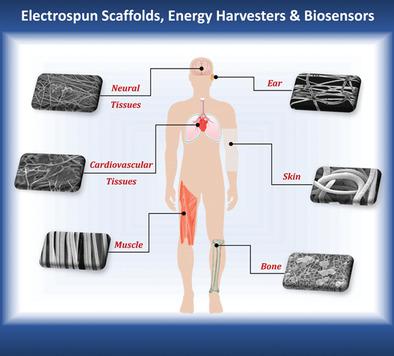当前位置:
X-MOL 学术
›
Adv. Healthcare Mater.
›
论文详情
Our official English website, www.x-mol.net, welcomes your
feedback! (Note: you will need to create a separate account there.)
Electrospinning Piezoelectric Fibers for Biocompatible Devices.
Advanced Healthcare Materials ( IF 10.0 ) Pub Date : 2019-11-08 , DOI: 10.1002/adhm.201901287 Bahareh Azimi 1, 2 , Mario Milazzo 1 , Andrea Lazzeri 2 , Stefano Berrettini 3 , Mohammed Jasim Uddin 4 , Zhao Qin 1 , Markus J Buehler 1 , Serena Danti 1, 2
Advanced Healthcare Materials ( IF 10.0 ) Pub Date : 2019-11-08 , DOI: 10.1002/adhm.201901287 Bahareh Azimi 1, 2 , Mario Milazzo 1 , Andrea Lazzeri 2 , Stefano Berrettini 3 , Mohammed Jasim Uddin 4 , Zhao Qin 1 , Markus J Buehler 1 , Serena Danti 1, 2
Affiliation

|
The field of nanotechnology has been gaining great success due to its potential in developing new generations of nanoscale materials with unprecedented properties and enhanced biological responses. This is particularly exciting using nanofibers, as their mechanical and topographic characteristics can approach those found in naturally occurring biological materials. Electrospinning is a key technique to manufacture ultrafine fibers and fiber meshes with multifunctional features, such as piezoelectricity, to be available on a smaller length scale, thus comparable to subcellular scale, which makes their use increasingly appealing for biomedical applications. These include biocompatible fiber-based devices as smart scaffolds, biosensors, energy harvesters, and nanogenerators for the human body. This paper provides a comprehensive review of current studies focused on the fabrication of ultrafine polymeric and ceramic piezoelectric fibers specifically designed for, or with the potential to be translated toward, biomedical applications. It provides an applicative and technical overview of the biocompatible piezoelectric fibers, with actual and potential applications, an understanding of the electrospinning process, and the properties of nanostructured fibrous materials, including the available modeling approaches. Ultimately, this review aims at enabling a future vision on the impact of these nanomaterials as stimuli-responsive devices in the human body.
中文翻译:

用于生物相容性设备的静电纺丝压电纤维。
纳米技术领域因其开发具有前所未有的特性和增强的生物反应的新一代纳米材料的潜力而取得了巨大的成功。使用纳米纤维尤其令人兴奋,因为它们的机械和形貌特征可以接近天然生物材料中的特征。静电纺丝是制造具有压电等多功能特征的超细纤维和纤维网的关键技术,可在较小的长度尺度上使用,从而与亚细胞尺度相当,这使得它们的使用对生物医学应用越来越有吸引力。其中包括基于生物相容性纤维的设备,如智能支架、生物传感器、能量采集器和人体纳米发电机。本文对目前的研究进行了全面的回顾,重点是专门为生物医学应用而设计或有可能转化为生物医学应用的超细聚合物和陶瓷压电纤维的制造。它提供了生物相容性压电纤维的应用和技术概述,以及实际和潜在的应用,对静电纺丝过程的理解以及纳米结构纤维材料的特性,包括可用的建模方法。最终,本次审查的目的是对这些纳米材料作为人体刺激响应装置的影响提出未来的愿景。
更新日期:2020-01-08
中文翻译:

用于生物相容性设备的静电纺丝压电纤维。
纳米技术领域因其开发具有前所未有的特性和增强的生物反应的新一代纳米材料的潜力而取得了巨大的成功。使用纳米纤维尤其令人兴奋,因为它们的机械和形貌特征可以接近天然生物材料中的特征。静电纺丝是制造具有压电等多功能特征的超细纤维和纤维网的关键技术,可在较小的长度尺度上使用,从而与亚细胞尺度相当,这使得它们的使用对生物医学应用越来越有吸引力。其中包括基于生物相容性纤维的设备,如智能支架、生物传感器、能量采集器和人体纳米发电机。本文对目前的研究进行了全面的回顾,重点是专门为生物医学应用而设计或有可能转化为生物医学应用的超细聚合物和陶瓷压电纤维的制造。它提供了生物相容性压电纤维的应用和技术概述,以及实际和潜在的应用,对静电纺丝过程的理解以及纳米结构纤维材料的特性,包括可用的建模方法。最终,本次审查的目的是对这些纳米材料作为人体刺激响应装置的影响提出未来的愿景。











































 京公网安备 11010802027423号
京公网安备 11010802027423号